
What is maintenance and why is it important in ABA
Ensuring Long-Term Success in ABA Through Effective Maintenance
Understanding Maintenance in ABA Therapy
Maintenance in ABA therapy is a foundational concept that pertains to the persistence and retention of skills after formal interventions have ended. It ensures that behaviors learned during therapy continue to be functional, useful, and generalizable across various real-life environments such as home, school, and community settings. This article explores what maintenance involves, why it is critical, and the strategies used by practitioners, parents, and stakeholders to promote durable behavior change.
Defining Maintenance in ABA Therapy

What is maintenance in ABA therapy?
Maintenance in ABA therapy is the process through which a learned skill continues to be performed even after formal teaching, prompts, and reinforcement procedures are withdrawn. It involves the individual's ability to retain behaviors they have acquired through intervention and apply them effectively in real-world settings like home, school, or community environments.
This concept ensures that skills are not only learned during therapy but also stay with the individual over time, even when prompting or reinforcement is no longer given consistently. To promote maintenance, therapists often fade prompts gradually, eliminate contrived reinforcements, and reinforce skills intermittently over spaced intervals. These strategies help prevent the individual from becoming prompt-dependent and enable behaviors to be carried out independently.
A practical example of maintenance is a child who learns to brush their teeth with visual schedules and reinforcement cues. Once these supports are removed, if the child continues to brush their teeth regularly, it indicates the skill has been maintained. This ongoing ability to perform skills automatically and independently is the primary goal of maintenance in ABA.
Maintaining skills is especially crucial for children with autism spectrum disorder (ASD) because it ensures that learned behaviors translate into everyday life, supporting increased independence and quality of life. Overall, maintenance reflects the lasting impact of ABA interventions, emphasizing the transfer of skills to varied contexts and their resilience over time.
Why Maintaining Skills Is Crucial in ABA Therapy
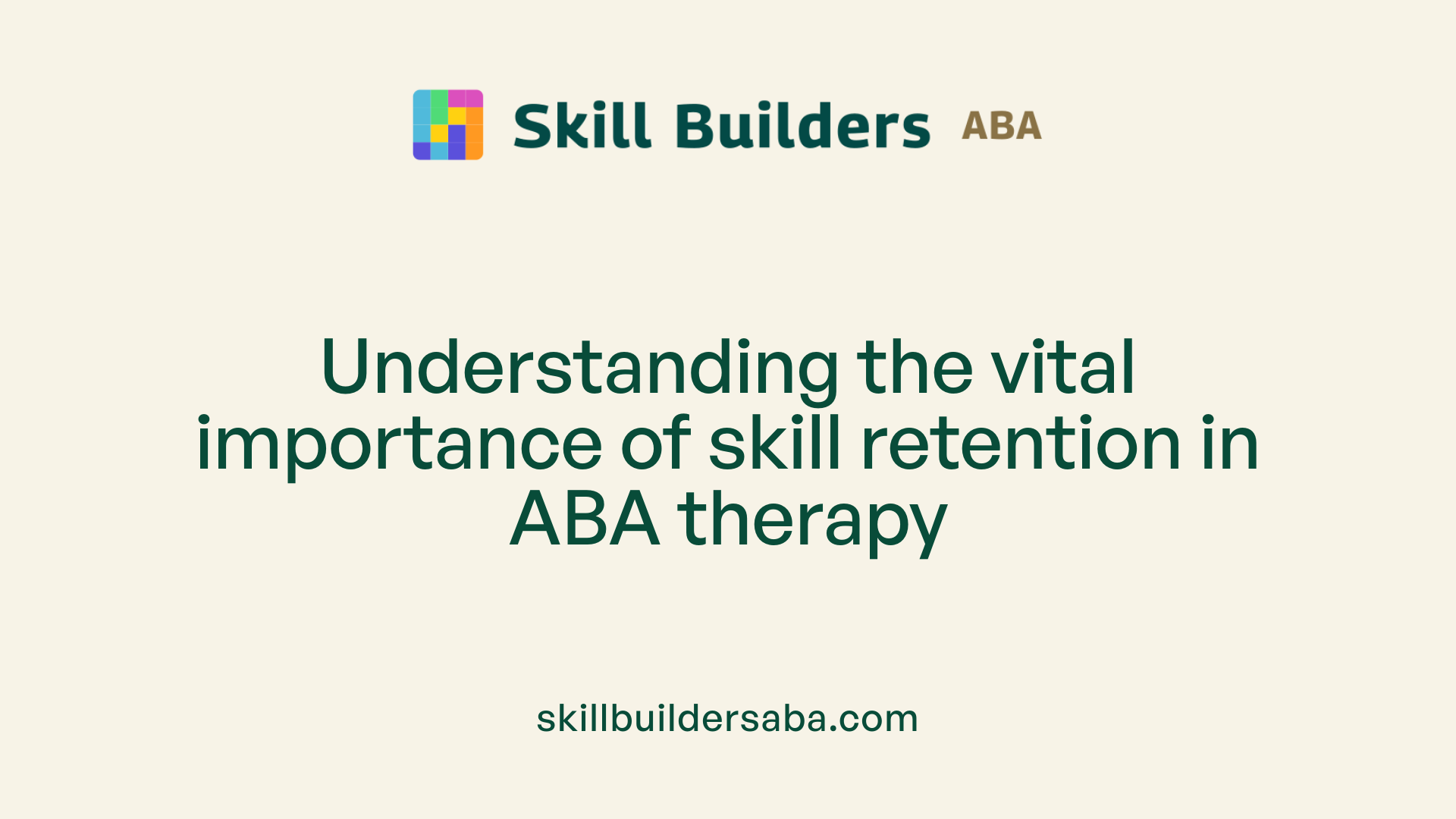
Why is maintenance important in ABA therapy?
In ABA therapy, maintaining skills is fundamental for ensuring that the progress made during intervention translates into real-world improvements. When skills are retained over time, individuals can perform them independently in everyday situations like home, school, and community settings.
Effective maintenance involves more than just teaching; it includes fading prompts and reinforcement gradually to prevent dependence. This process helps the skill become part of the individual’s natural repertoire, making it more likely to be used even without ongoing support.
Regular assessments, including follow-up skill probes, are essential tools to monitor if skills are being retained. If a skill begins to fade, clinicians can intervene early by re-strengthening it through targeted reinforcement or additional practice.
By promoting generalization across different environments and situations, maintenance ensures that skills are not confined to the therapy setting but are useful, functional, and sustainable long-term. Without these strategies, there is a risk of regression, which can undermine the overall effectiveness of the intervention.
In summary, maintaining skills supports independence, facilitates positive life outcomes, and ensures that the efforts of therapy continue to benefit the individual well beyond the formal intervention period.
Achieving Maintenance Through Systematic Practice and Reinforcement
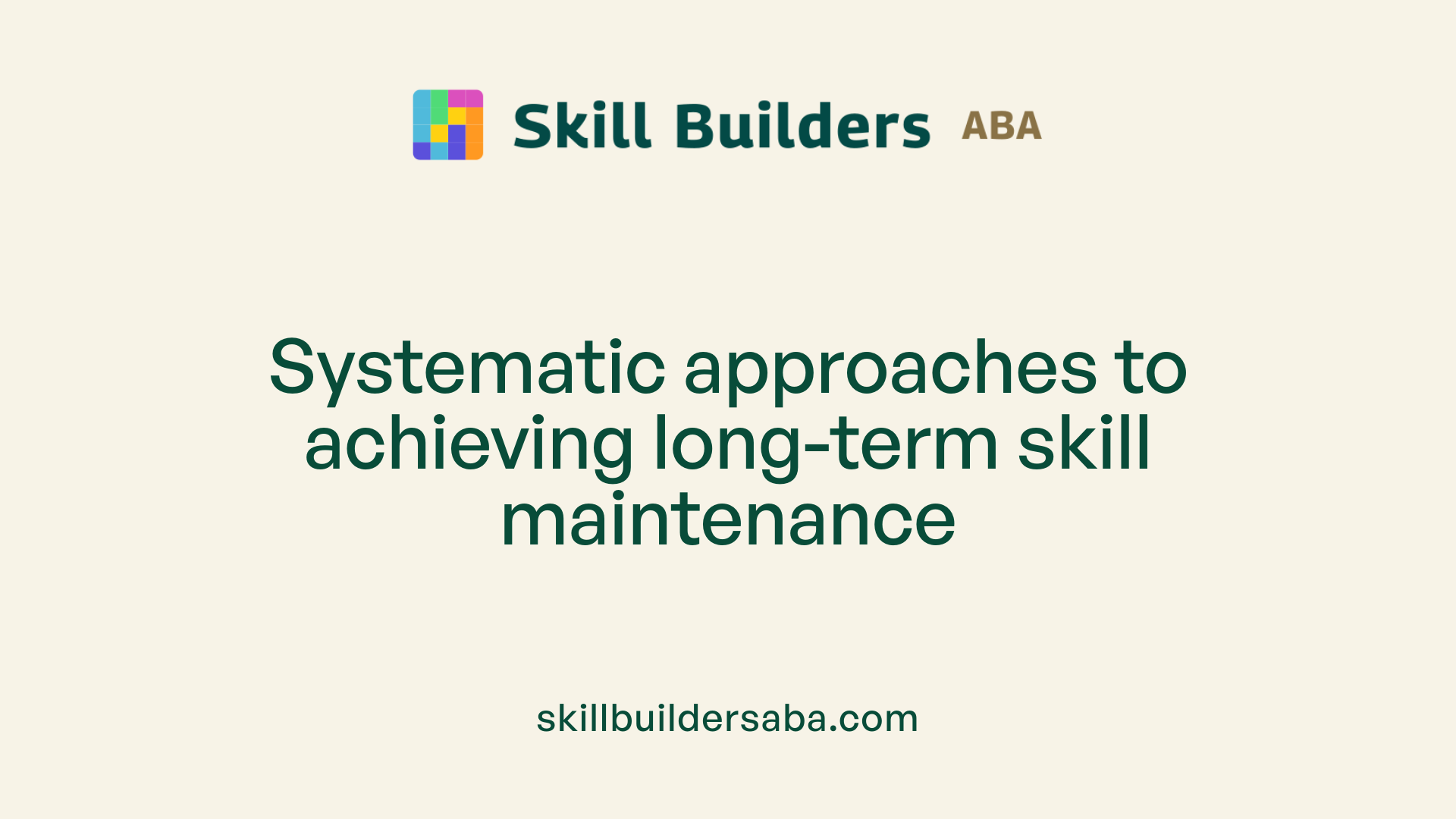
How is maintenance of a learned skill achieved in ABA?
In ABA, maintaining a skill involves a combination of consistent practice, reinforcement, and strategies aimed at promoting skill retention over time. Once a skill has been mastered, therapists focus on fading prompts and reinforcement gradually, ensuring the individual can perform the skill independently in various contexts.
A critical component is involving caregivers and using natural settings. Training parents, teachers, and other natural caregivers helps embed the skill into daily routines and spontaneous activities, making retention more natural and durable.
Ongoing assessments, including follow-up probes and data collection, are essential for tracking progress and determining when additional practice or reinforcement might be necessary. This continuous process ensures intervention effects are maintained and prevents regression.
Natural reinforcement, which occurs in everyday life without contrived rewards, plays a vital role in ensuring skills are meaningful and retained without external prompts. Integrating skills into real-world situations supports generalization and long-term sustainability.
Overall, skill maintenance in ABA is a systematic, long-term endeavor. It involves planning, gradual fading of prompts and reinforcements, caregiver involvement, and continual monitoring to help skills become part of the individual’s natural repertoire and daily life.
The Connection Between Maintenance and Generalization
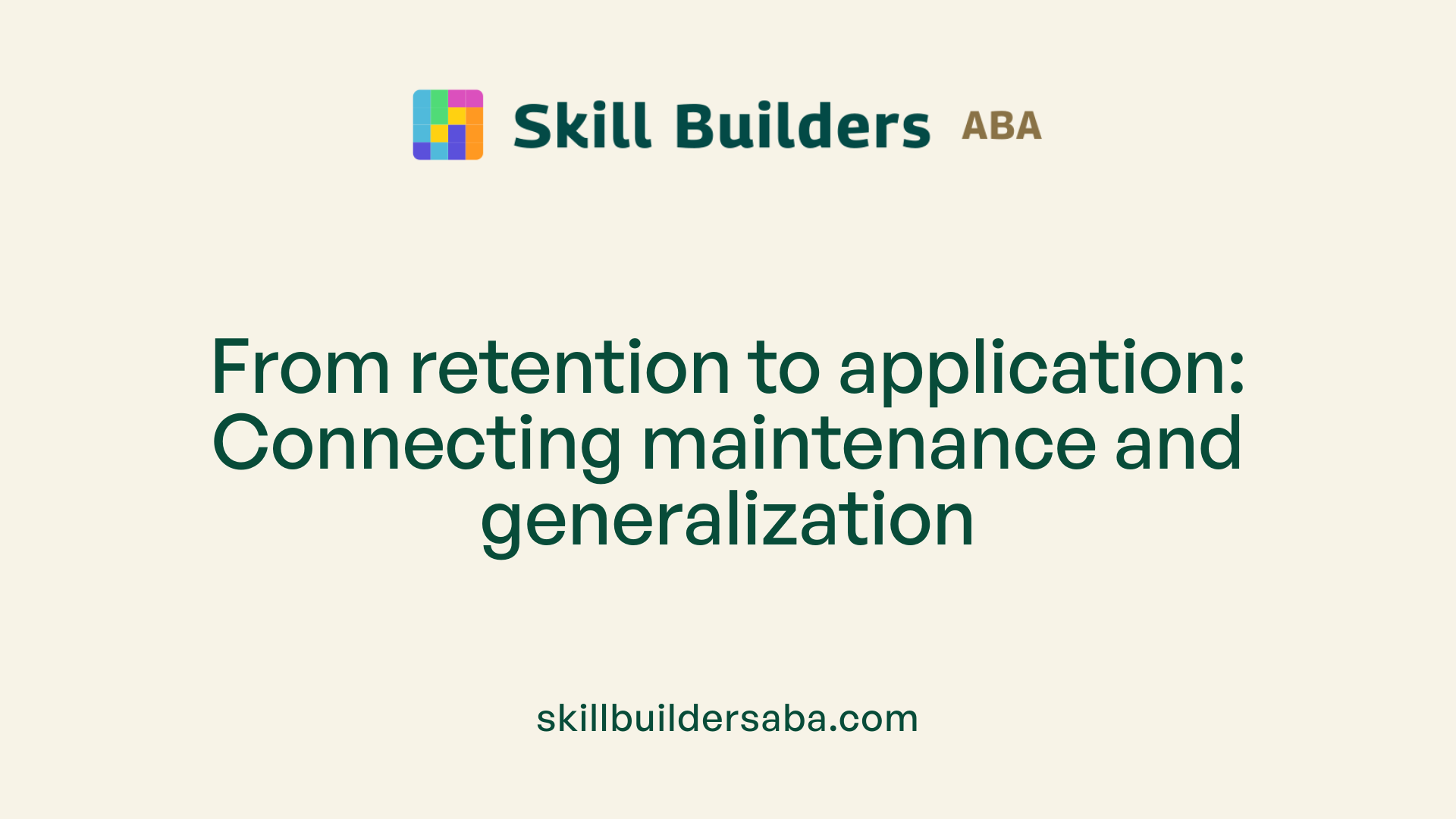
How maintenance supports generalization
Maintenance and generalization are interconnected aspects of effective ABA therapy. Maintenance ensures that skills acquired during instruction are retained over time, even after formal intervention has ended. When skills are maintained, individuals can apply them consistently across various situations, which naturally leads to generalization.
For example, a child taught to greet others politely in therapy sessions will continue to do so in different settings like school or home if the skill is well-maintained. This ongoing use of skills beyond the original training environment confirms that the behavior has generalized.
Moreover, maintenance acts as a foundation for generalization. When skills are reliably retained, they become more likely to be adapted and transferred to new stimuli, environments, and social partners, making interventions more robust and impactful.
Training across different settings and stimuli
To promote both maintenance and generalization, practitioners often train across multiple settings and with various stimuli. This approach exposes individuals to diverse contexts that mimic real-life situations.
Using multiple exemplars—examples that differ in stimuli, responses, or environments—helps individuals learn flexible skills that can be transferred easily.
Common stimuli programming involves incorporating items or cues that are frequently encountered in daily life, such as different toys, locations, or people. This diversity ensures that a skill learned in one setting is more likely to be maintained and generalized.
Natural contingencies, where reinforcement occurs in typical routines and everyday interactions, further promote skills' durability and their application across settings.
Strategies to promote both maintenance and generalization
A range of strategies can help ensure skills are retained and transferable:
- Fading prompts and reinforcement: Gradually reducing prompts and reinforcers prevents dependency and ensures independence.
- Training with natural reinforcement: Using reinforcers that naturally occur can sustain behavior without external prompts.
- Using multiple exemplars and programming common stimuli: These methods foster flexibility and applicability.
- Intermittent reinforcement schedules: Reinforcing behaviors at variable rates encourages long-term retention.
- Caregiver and environment involvement: Training parents, teachers, and caregivers ensures skills are practiced across settings.
By systematically applying these strategies, individuals not only keep their skills over time but also learn to adapt them to new contexts, increasing overall treatment success.
| Strategy | Focus Area | Purpose | Examples |
|---|---|---|---|
| Fading prompts & reinforcement | Maintenance & Generalization | Reduce prompts and praise gradually | Removing visual cues, decreasing reinforcement frequency |
| Multiple exemplars | Generalization | Teach with varied stimuli and responses | Different toys, locations, social partners |
| Natural reinforcement | Maintenance & Generalization | Use real-life rewards | Receiving praise after cleaning teeth |
| Intermittent reinforcement | Maintenance | Sustain behaviors over time | Reinforcing a skill randomly rather than constantly |
In summary, maintaining skills and enabling their generalization are fundamental components of successful ABA treatment. By intentionally designing therapy programs that incorporate diverse stimuli, natural reinforcers, and fading strategies, practitioners can help individuals retain skills and apply them broadly in their daily lives.
Strategies and Methods to Sustain Behaviors

What are some strategies and methods to promote maintenance of behaviors in ABA?
Maintaining skills over time is a vital part of behavior analysis (ABA) therapy. To ensure that learned behaviors continue to be performed independently, practitioners use several strategies. One common approach involves systematically fading prompts and reinforcements. This means gradually reducing adult cues, visual supports, and reinforcement schedules to promote independent performance without reliance on external prompts.
Fading task requirements is another essential method. As learners demonstrate mastery, the demands of the task are slowly increased or altered, helping to strengthen the skill and prevent prompt dependency. Over time, reinforcement procedures are also adjusted, moving from contrived rewards to more natural consequences that occur in real-world settings.
Promoting generalization is equally important for long-term maintenance. It includes practicing skills across different environments, with various people, and in a range of situations. Training loosely, using multiple exemplars, and programming common stimuli in teaching activities are strategies that encourage skills to be retained outside the initial training context.
Incorporating natural reinforcers—those that naturally follow a behavior in everyday life—helps make skills meaningful and more likely to be retained. Providing learners with opportunities to apply skills in real situations enhances their practicality and encourages natural reinforcement.
Regular practice and data collection are fundamental. Monitoring progress over time allows therapists and caregivers to identify skills that remain robust or need additional support. Collaboration among professionals and caregivers ensures interventions stay personalized, relevant, and effective for long-term success.
Overall, these strategies foster the sustainable retention of skills, reducing the risk of regression and supporting individuals in applying their skills independently across various life contexts.
The Role of Mastery Criteria in Ensuring Maintenance

What are mastery criteria?
Mastery criteria are specific standards set within ABA programs that define when a skill is considered learned or mastered. These standards typically include measurable levels of accuracy, such as achieving a certain percentage of correct responses (e.g., 80% or 100%) across a specified number of observational sessions. Meeting these criteria indicates that the learner has sufficiently learned the skill to generalize and maintain it independently.
How do mastery criteria influence maintenance?
Higher mastery levels, like 100% accuracy, tend to promote better long-term retention of skills. When learners reach these stringent standards, they demonstrate a solid understanding and application of the skill, reducing the likelihood of regression.
By establishing clear benchmarks, practitioners can systematically ensure that skills are well-established before proceeding or reducing prompts. This structured approach prepares the individual for natural environment challenges, fostering independence and skill sustainability.
Additionally, consistent achievement of mastery across multiple sessions suggests that the skill is resistant to fading and can be maintained over time without continuous prompts or reinforcement.
Research findings on mastery level effects
Research supports that setting high mastery criteria correlates with improved maintenance of skills. Studies indicate that when learners attain 100% accuracy over fewer sessions, these skills are more likely to persist long-term.
Conversely, lower mastery thresholds, such as 80%, often lead to less durable skills, with higher risks of regression when reinforcement diminishes or contexts change.
Many recent investigations include follow-up probes to assess maintenance after mastery is achieved. These studies frequently find that skills acquired at higher accuracy levels are maintained more effectively.
However, there's a noted discrepancy between research and practice. Practitioners often use lower mastery standards (around 80%) across more sessions, which may not support optimal long-term maintenance. Further research is needed to refine mastery criteria to enhance durability.
What are the best practices for setting mastery criteria?
| Criteria Level | Approximate Accuracy | Number of Sessions | Impact on Maintenance |
|---|---|---|---|
| Low | 80% | More sessions | Reduced durability |
| High | 100% | Fewer sessions | Better retention |
Aligning mastery criteria with research findings can help ensure that learned skills are retained and functional in everyday settings. Regular follow-up assessments post-mastery are vital to confirm the longevity of skills.
How is maintenance of a learned skill achieved in ABA?
Maintenance involves a combination of consistent practice, reinforcement strategies, caregiver involvement, and generalization across different settings. Techniques such as fading prompts, gradually reducing reinforcement schedules, and practicing skills in real-world contexts are instrumental in consolidating skills. Continuous data collection and progress monitoring help identify when additional practice or reinforcement adjustments are needed. Ultimately, integrating skills into daily routines and emphasizing natural reinforcement sources support the ongoing stability of learned behaviors.
Research and Practice: A Gap in Maintenance Reporting
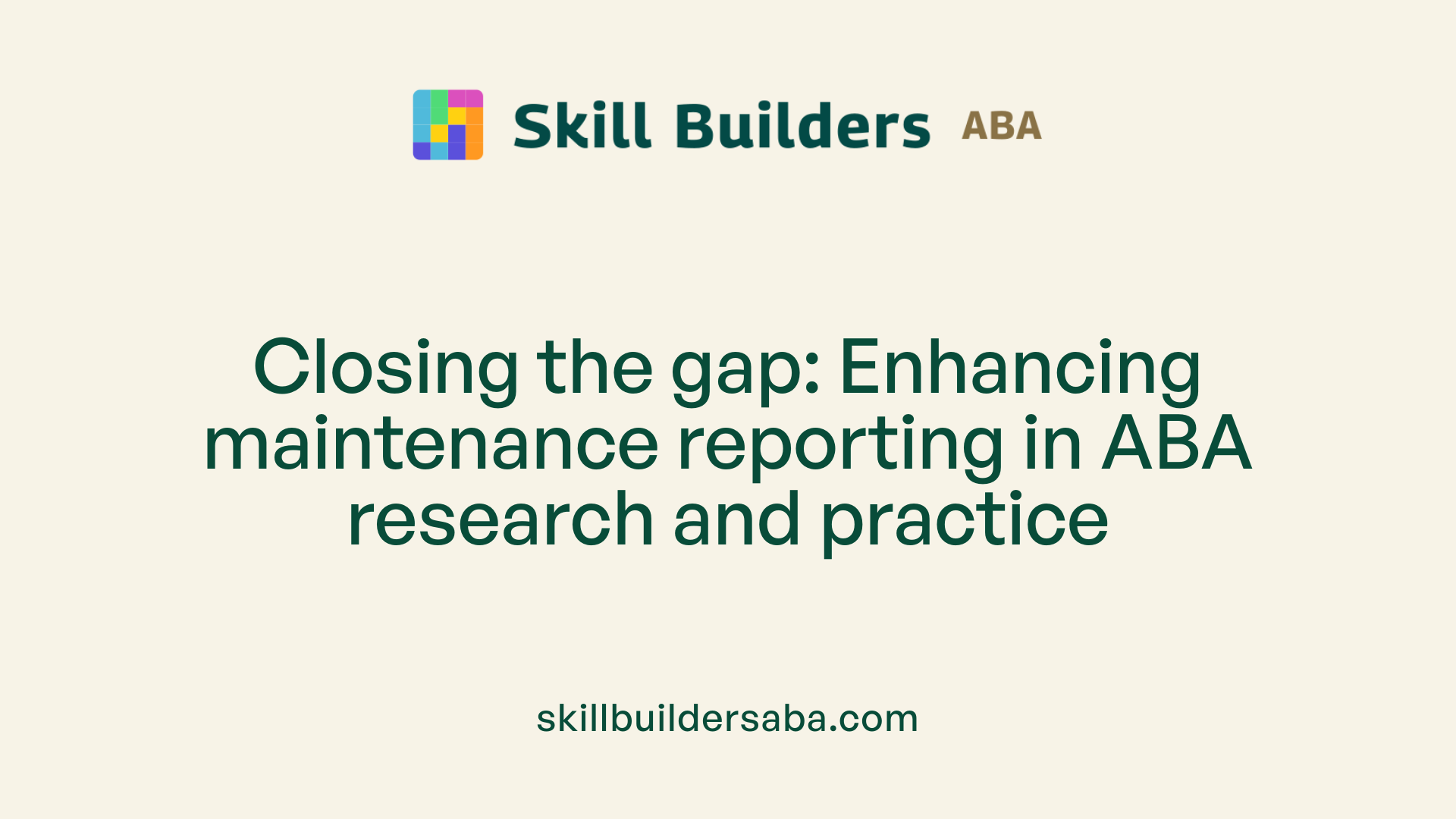
What is maintenance in ABA therapy?
Maintenance in ABA therapy refers to the continued performance and retention of a skill after formal teaching and interventions have been discontinued. It is essential for ensuring that learned behaviors are functional and generalize across different environments and situations, such as home and school.
Strategies to promote maintenance include gradually fading reinforcement, withdrawing antecedents, and practicing skills over intervals of time to prevent skill loss. Maintaining skills enables individuals, especially children on the autism spectrum, to apply behaviors independently in their daily lives, supporting long-term success.
Overall, maintenance is a critical goal in ABA, demonstrating that skills have been fully acquired, retained, and are useful beyond therapy sessions.
Differences between research and practice in mastery criteria
In the scientific community, studies often use high mastery standards, such as 100% accuracy across limited sessions, to ensure the skill is truly acquired. These research-based mastery criteria help to predict whether a skill will maintain over time.
However, practitioners in real-world settings frequently adopt lower accuracy levels, around 80%, spread over more sessions. This discrepancy can impact long-term retention, as lower mastery standards may not produce durable skill maintenance.
Additionally, many research studies include follow-up probes after mastery is achieved to assess lasting skills. Conversely, practice settings often lack systematic maintenance assessments, resulting in less reliable long-term data.
The importance of maintenance probes in research and practice
Maintenance probes are assessments conducted after a skill is initially mastered to verify its persistence over time without additional coaching or prompts. In research, these are standard to ensure that a skill is truly ingrained.
In practice, however, numerous studies highlight that many do not incorporate or report on these maintenance checks. This omission raises concerns because it limits understanding of whether teaching interventions lead to enduring behaviors.
Without consistent maintenance probing, practitioners may overestimate skill retention, jeopardizing long-term success and independence for individuals with autism.
Need for more empirical data on maintenance
There is a clear need for ongoing research focusing on optimal mastery criteria and maintenance strategies. Current evidence suggests that higher accuracy standards and fewer sessions to reach mastery correlate with better long-term retention.
Further studies should explore how different fading methods, reinforcement schedules, and real-world practice influence maintenance. Gathering more data will enable practitioners to establish evidence-based guidelines for effective long-term skill retention.
Bridging the gap between research and practice involves adopting empirically supported mastery criteria, routinely conducting maintenance assessments, and sharing outcomes to refine ABA methodologies. This approach ensures that skills acquired in therapy are durable, functional, and genuinely beneficial in everyday life.
The Long-Term Perspective on Behavioral Skills in ABA
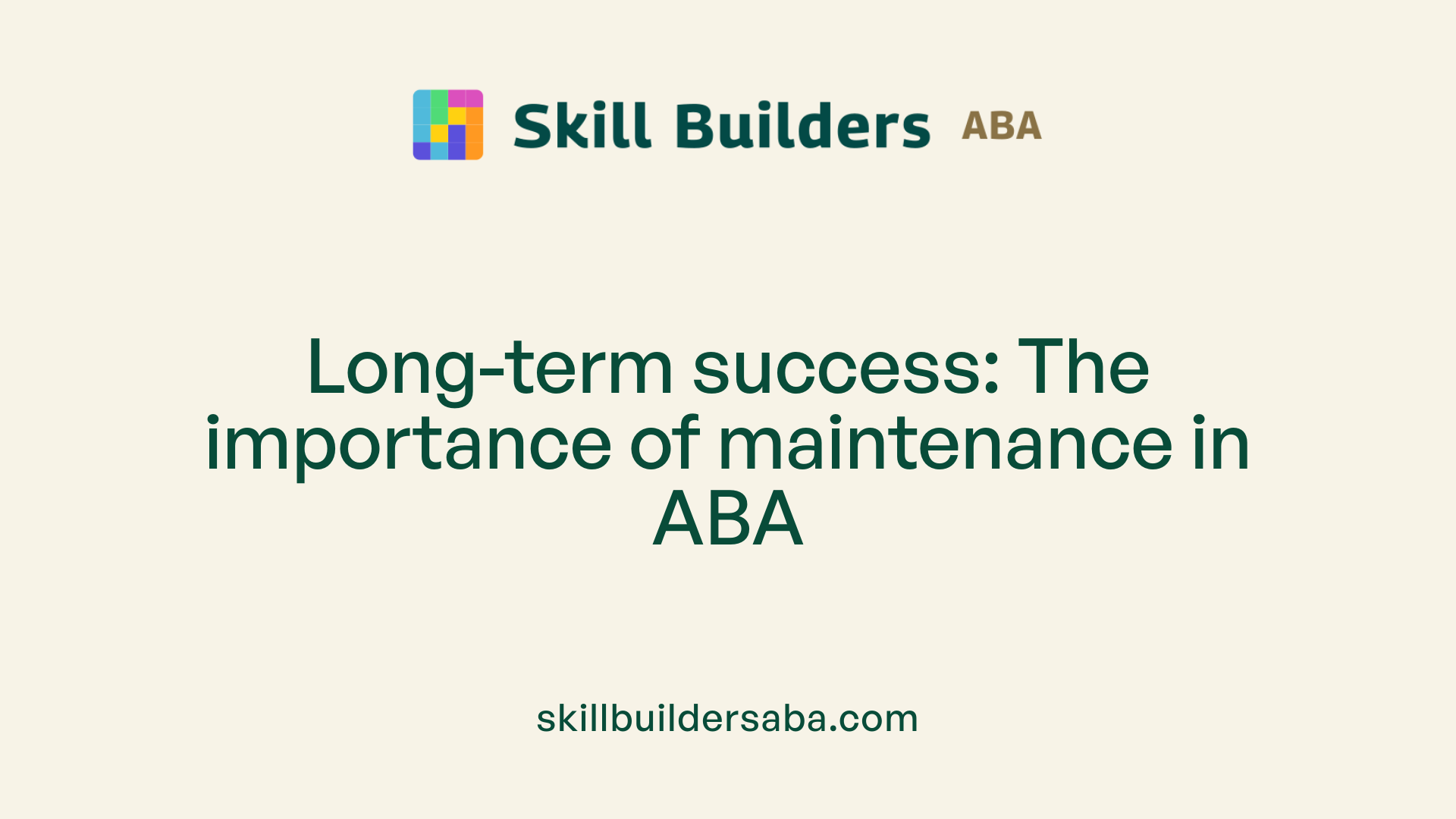
Why is maintenance important in ABA therapy?
Maintenance plays a crucial role in Applied Behavior Analysis (ABA) because it ensures that individuals retain and can independently perform skills they have learned during therapy. This retention is vital across different settings such as home, school, and community environments, making sure that the skills are functional and useful in everyday life.
Without effective maintenance strategies, skills acquired during ABA interventions may fade over time. This regression undermines the long-term benefits of therapy, necessitating repeated teaching and wasting valuable resources.
To promote skill retention, therapists often use approaches like gradually fading prompts and reinforcements. Natural contingencies and intermittent reinforcement schedules help embed skills so they are maintained naturally within their environment. Routine assessments and skill probes are essential for monitoring whether the skills remain intact and are being effectively utilized.
By focusing on maintenance, therapists can help individuals achieve sustained behavioral improvements. These efforts support the long-lasting application of skills, maximizing the positive impact of ABA therapy on an individual's independence and overall quality of life.
Long-term benefits of maintenance
Long-term maintenance of skills in ABA offers numerous benefits beyond immediate learning outcomes. When skills are retained, individuals are better equipped to navigate various situations confidently and safely.
This ongoing ability reduces dependency on external prompts and support, fostering greater independence. For example, a child who learns self-care routines like tooth brushing and maintains these routines over time can enjoy improved health and hygiene without constant supervision.
Skill retention also reduces the need for repeated interventions, saving time and resources. It provides a stable foundation for learners to build more complex behaviors, thereby supporting progressive development.
Furthermore, consistent performance of important skills contributes to a sense of accomplishment and self-esteem. It promotes resilience, enabling individuals to adapt to changing environments and new challenges.
Impact on quality of life
Sustained behavioral skills significantly enhance an individual's quality of life. When skills such as communication, self-care, social, and daily living routines are maintained, individuals experience greater independence and social participation.
For individuals with autism spectrum disorder (ASD) and other developmental disabilities, skill maintenance prevents regression and ensures consistent functioning across different life areas. This continuity fosters confidence and facilitates smoother transitions between environments or routines.
Moreover, the ability to apply learned skills in natural settings reduces stress for caregivers and promotes positive interactions within community and family contexts.
Overall, the emphasis on long-term maintenance ensures that the benefits of ABA translate into meaningful improvements in daily functioning, wellbeing, and social integration, ultimately leading to a higher quality of life for individuals with developmental challenges.
Final Remarks on the Significance of Maintenance in ABA
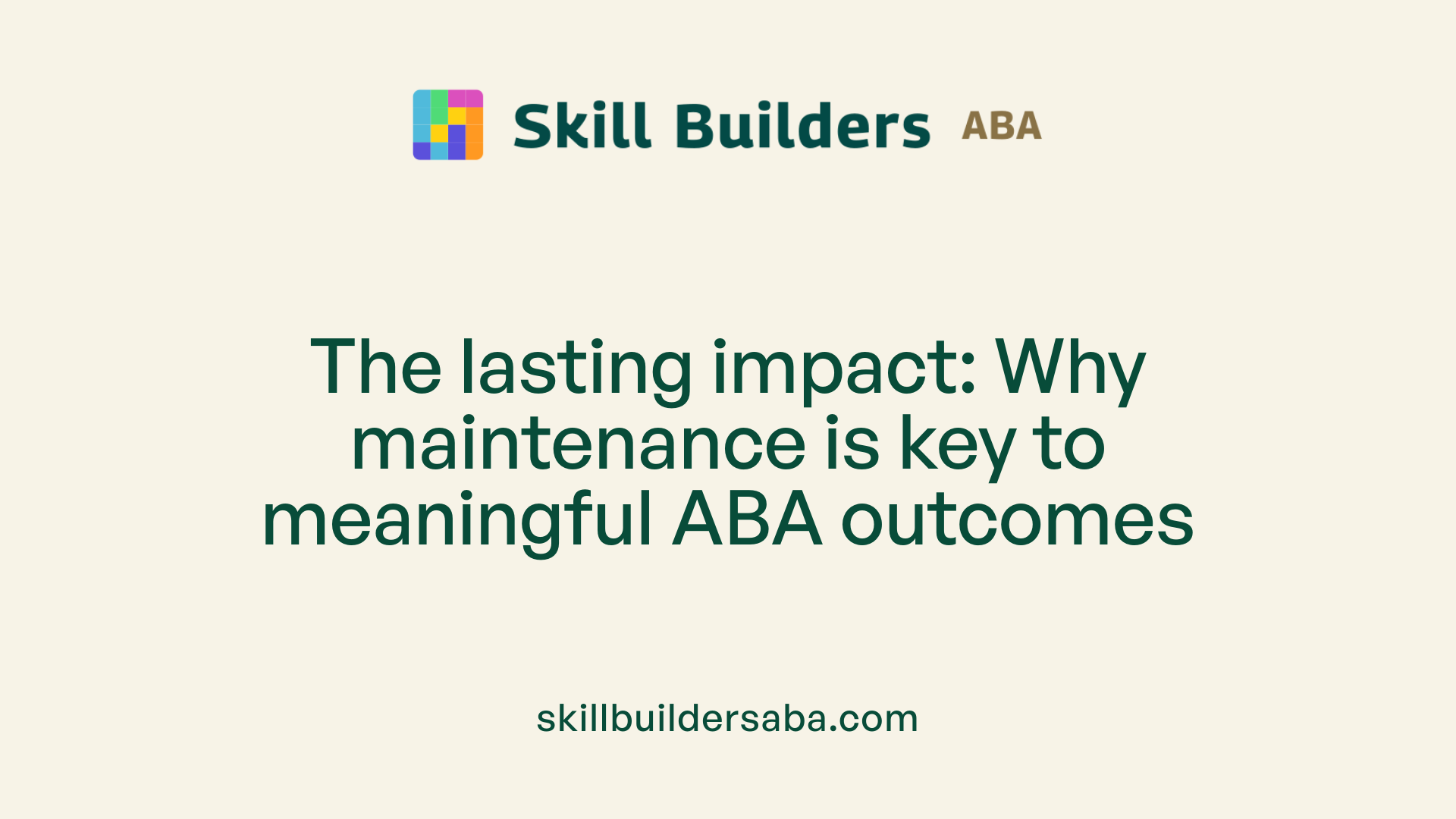
What is maintenance in ABA therapy?
Maintenance in ABA therapy refers to the ability to retain and continue performing a skill after the teaching procedures have been removed. Rather than simply acquiring a new behavior, maintenance ensures that the behavior persists over time, across different settings, and with various people. It is crucial for transforming learned skills into practical, everyday behaviors that support independence.
Strategies to promote maintenance include gradually fading prompts and reinforcements, withdrawing antecedents, and practicing skills over spaced intervals. These methods prevent dependency on prompts or artificial rewards, fostering natural and sustainable behavior. For example, a child taught to brush their teeth with visual cues and reinforcement will continue to do so even after these supports are removed, demonstrating effective skill retention.
In essence, maintenance involves continuous efforts to help individuals apply their skills in real-world contexts, ensuring that behaviors are not only learned but also lasting and functional in daily life. This aspect of ABA is vital for long-term success, especially for individuals with autism spectrum disorder, as it promotes independence and quality of life beyond therapeutic environments.
The Power of Effective Maintenance
In ABA, maintenance is not just an end goal but an ongoing process that ensures each skill acquired is retained, generalized, and applied across all areas of the individual’s life. It bridges the gap between skill acquisition and real-world independence, making therapy truly meaningful. Practitioners, parents, and stakeholders must prioritize maintenance through systematic strategies such as fading prompts, natural reinforcement, and thorough follow-up assessments. Emphasizing maintenance fosters sustainable behavioral change, enhances quality of life, and ultimately leads to more effective, long-lasting treatment outcomes in autism support. With ongoing dedication to these practices, individuals on the spectrum can achieve greater independence and meaningful participation in their communities.
References
- Maintenance: An ABA Technique - Golden Care Therapy
- Generalization and Maintenance in Applied Behavior Analysis
- Mastery Criteria and Maintenance: a Descriptive Analysis of Applied ...
- 5 Essential Aspects of Maintenance ABA Definition You Should Know
- What about maintenance programs?
- Maintenance - ABA Study Guide
- Maintenance: An ABA Technique - Golden Care Therapy
Learn More and Take the First Step
If you’d like a clearer understanding of how our programs work, begin by exploring our site at your own pace. And when you're ready for a conversation about next steps, you can get in touch with a coordinator.
Reach Out Today
Learn more about how we can support your child’s growth and development. Contact us to discuss our services and availability in your area.
.svg)